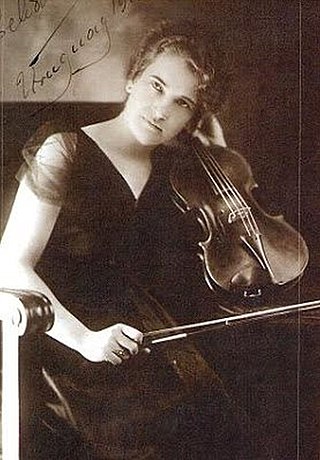Top Qs
Timeline
Chat
Perspective
Celia Torrá
Argentine composer From Wikipedia, the free encyclopedia
Remove ads
Celia Torrá (18 September 1889 – 16 December 1962)[1] was an Argentine composer, conductor, and violinist.[2] She was the first woman to conduct an orchestra at the Teatro Colón.[3]

Torrá was born in Concepción del Uruguay, Entre Rios, Argentina. Her father was her first violin teacher.[4] She later studied music with Andres Gaos, Athos Palma,[5] and Alberto Williams.[6]
In 1909, she won a National Commission of Fine Arts prize which funded her studies in Europe with Vincent d'Indy, Jenő Hubay, Zoltán Kodály, Paul Le Flem, and César Thomson.[7] She won the Royal Conservatory of Brussels' Grand Prix for violin in 1911. The Entre Rios provincial government gave her a grant to continue her studies in Europe.[8] She remained in France during World War I, where she gave benefit concerts for the Red Cross.[4]
In 1921, Torrá returned to Argentina where she was the first female conductor at the Teatro Colón.[8] In 1930, she founded and directed the Asociación Coral Femenina, which later merged with the Asociación Sinfónica Femenina.[9]
Torrá conducted both groups in over 200 concerts. In 1952, she founded a choir for the employees of Philips Argentina S.A., the first workers choir in Argentina.[4]
Remove ads
Chamber
Orchestra
Piano
- Sonata[11]
Vocal
- "A la patria"[12]
- "Abandono (Carmen latino")[12]
- "Alborada"[12]
- "Atardecer"[8]
- "Cacharros y ponchitos"[12]
- "Cantar de arriero" (text by Rafael Jijena Sánchez)[12]
- "Capillas"[12]
- "Changuito (Canción infantil)" (text by Adela Christensen)[12]
- Coqueando (women's chorus and piano)[8]
- "Crepuscula"r[12]
- El aguila (women's chorus and piano)[8]
- El arroyo y luna y nieve en huillapina (chorus and orchestra)[8]
- "El sauce"[12]
- "Himno a la paz"[12]
- Himno a la raza (chorus and orchestra)[8]
- "Himno del liceo"[12]
- "La campana"[12]
- "La gallina ponedora"[12]
- "La señora semana"[12]
- Las campanas (chorus; arrangement of melody by Juan Hidaldo)[8]
- "Las palomitas"[12]
- "Los amigos" [12]
- "Marcha patriótica"[12]
- "Mi reloj"[12]
- "Milonga del destino" (Text: Fernán Silva Valdés)[12]
- O María Virgo (women's chorus and organ)[8]
- "Oración a la bandera"[12]
- "Otoño"[12]
- Pampeana (male chorus)[8]
- "Primavera"[12]
- "Quisiera eternizarme"[12]
- "Seis Coplas"[12]
- Tota pulchra (women's chorus and organ)[8]
- "Vida, vidita" (Text: Rafael Jijena Sánchez)[12]
- "Visión de paz"[12]
Remove ads
References
External links
Wikiwand - on
Seamless Wikipedia browsing. On steroids.
Remove ads
